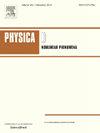Non-binary dynamical Ising machines for combinatorial optimization
IF 2.7
3区 数学
Q1 MATHEMATICS, APPLIED
引用次数: 0
Abstract
Dynamical Ising machines achieve accelerated solving of complex combinatorial optimization problems by remapping the convergence to the ground state of the classical spin networks to the evolution of specially constructed continuous dynamical systems. The main adapted principle guiding the design of such systems is based on requiring that, on the one hand, the system converges to a binary state and, on the other hand, the system’s energy in such states mimics the classical Ising Hamiltonian. The emergence of binary-like states is regarded to be an indispensable feature of dynamical Ising machines as it establishes the relation between the machine’s continuous terminal state and the inherently discrete solution of a combinatorial optimization problem. This is emphasized by problems where the unknown quantities are represented by spin complexes, for example, the graph coloring problem. In such cases, an imprecise mapping of continuous states to spin configurations may lead to invalid solutions requiring intensive post-processing. In contrast to this approach, we show that there exists a class of non-binary dynamical Ising machines without the incongruity between the continuous character of the machine’s states and the discreteness of the spin states. We demonstrate this feature by applying such a machine to the problems of finding the proper graph coloring, constructing Latin squares, and solving Sudoku puzzles. Thus, we demonstrate that the information characterizing discrete states can be unambiguously presented in essentially continuous dynamical systems. This opens new opportunities for the realization of scalable electronic accelerators of combinatorial optimization.
组合优化的非二元动态伊辛机
动态伊辛机通过将经典自旋网络的收敛到基态重新映射到特殊构造的连续动力系统的演化,实现了复杂组合优化问题的加速求解。指导这种系统设计的主要适应原则是基于要求,一方面,系统收敛到二进制状态,另一方面,系统在这种状态下的能量模仿经典的伊辛哈密顿量。类二进制状态的出现被认为是动态伊辛机器不可缺少的特征,因为它建立了机器的连续终端状态与组合优化问题的固有离散解之间的关系。这在用自旋配合物表示未知量的问题中得到了强调,例如,图着色问题。在这种情况下,连续状态到自旋配置的不精确映射可能导致需要大量后处理的无效解决方案。与此方法相反,我们证明了存在一类非二元动态伊辛机,在机器状态的连续特征与自旋状态的离散性之间没有不一致。我们通过将这样的机器应用于寻找适当的图着色、构造拉丁方块和解决数独难题来演示这一特性。因此,我们证明了表征离散状态的信息可以明确地呈现在本质上连续的动力系统中。这为实现可扩展的组合优化电子加速器提供了新的机会。
本文章由计算机程序翻译,如有差异,请以英文原文为准。
求助全文
约1分钟内获得全文
求助全文
来源期刊

Physica D: Nonlinear Phenomena
物理-物理:数学物理
CiteScore
7.30
自引率
7.50%
发文量
213
审稿时长
65 days
期刊介绍:
Physica D (Nonlinear Phenomena) publishes research and review articles reporting on experimental and theoretical works, techniques and ideas that advance the understanding of nonlinear phenomena. Topics encompass wave motion in physical, chemical and biological systems; physical or biological phenomena governed by nonlinear field equations, including hydrodynamics and turbulence; pattern formation and cooperative phenomena; instability, bifurcations, chaos, and space-time disorder; integrable/Hamiltonian systems; asymptotic analysis and, more generally, mathematical methods for nonlinear systems.
 求助内容:
求助内容: 应助结果提醒方式:
应助结果提醒方式:


